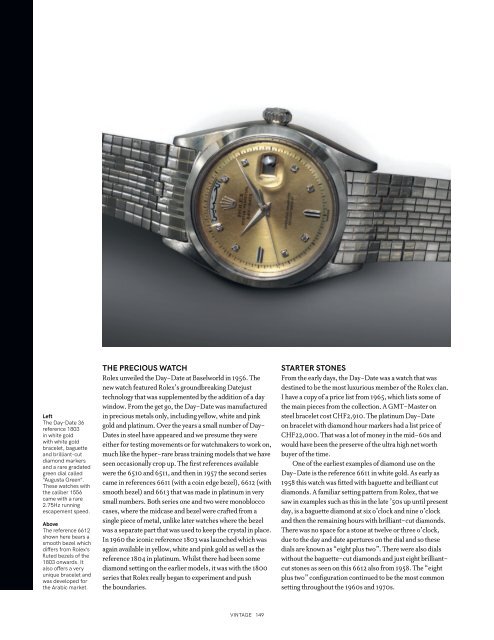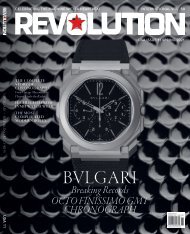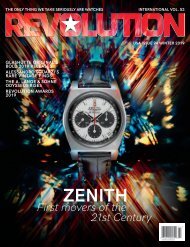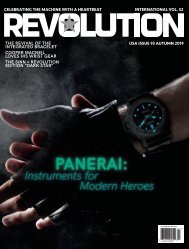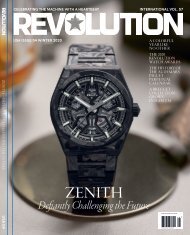You also want an ePaper? Increase the reach of your titles
YUMPU automatically turns print PDFs into web optimized ePapers that Google loves.
Left<br />
The Day-Date 36<br />
reference 1803<br />
in white gold<br />
with white gold<br />
bracelet, baguette<br />
and brilliant-cut<br />
diamond markers<br />
and a rare gradated<br />
green dial called<br />
“Augusta Green”.<br />
These watches with<br />
the caliber 1556<br />
came with a rare<br />
2.75Hz running<br />
escapement speed.<br />
Above<br />
The reference 6612<br />
shown here bears a<br />
smooth bezel which<br />
differs from Rolex’s<br />
fluted bezels of the<br />
1803 onwards. It<br />
also offers a very<br />
unique bracelet and<br />
was developed for<br />
the Arabic market.<br />
THE PRECIOUS WATCH<br />
Rolex unveiled the Day-Date at Baselworld in 1956. The<br />
new watch featured Rolex’s groundbreaking Datejust<br />
technology that was supplemented by the addition of a day<br />
window. From the get go, the Day-Date was manufactured<br />
in precious metals only, including yellow, white and pink<br />
gold and platinum. Over the years a small number of Day-<br />
Dates in steel have appeared and we presume they were<br />
either for testing movements or for watchmakers to work on,<br />
much like the hyper-rare brass training models that we have<br />
seen occasionally crop up. The first references available<br />
were the 6510 and 6511, and then in 1957 the second series<br />
came in references 6611 (with a coin edge bezel), 6612 (with<br />
smooth bezel) and 6613 that was made in platinum in very<br />
small numbers. Both series one and two were monoblocco<br />
cases, where the midcase and bezel were crafted from a<br />
single piece of metal, unlike later watches where the bezel<br />
was a separate part that was used to keep the crystal in place.<br />
In 1960 the iconic reference 1803 was launched which was<br />
again available in yellow, white and pink gold as well as the<br />
reference 1804 in platinum. Whilst there had been some<br />
diamond setting on the earlier models, it was with the 1800<br />
series that Rolex really began to experiment and push<br />
the boundaries.<br />
STARTER STONES<br />
From the early days, the Day-Date was a watch that was<br />
destined to be the most luxurious member of the Rolex clan.<br />
I have a copy of a price list from 1965, which lists some of<br />
the main pieces from the collection. A GMT-Master on<br />
steel bracelet cost CHF2,910. The platinum Day-Date<br />
on bracelet with diamond hour markers had a list price of<br />
CHF22,000. That was a lot of money in the mid-60s and<br />
would have been the preserve of the ultra high net worth<br />
buyer of the time.<br />
One of the earliest examples of diamond use on the<br />
Day-Date is the reference 6611 in white gold. As early as<br />
1958 this watch was fitted with baguette and brilliant cut<br />
diamonds. A familiar setting pattern from Rolex, that we<br />
saw in examples such as this in the late ’50s up until present<br />
day, is a baguette diamond at six o’clock and nine o’clock<br />
and then the remaining hours with brilliant-cut diamonds.<br />
There was no space for a stone at twelve or three o’clock,<br />
due to the day and date apertures on the dial and so these<br />
dials are known as “eight plus two”. There were also dials<br />
without the baguette-cut diamonds and just eight brilliantcut<br />
stones as seen on this 6612 also from 1958. The “eight<br />
plus two” configuration continued to be the most common<br />
setting throughout the 1960s and 1970s.<br />
VINTAGE 149


